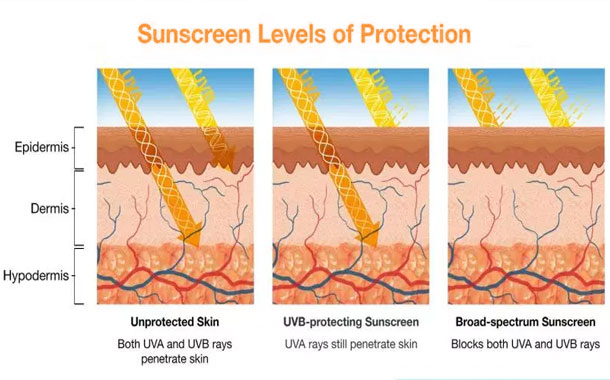The Technology Behind Sunscreens (And Why To Use Them In Tropical Countries)
Usage of sunscreens is – hopefully – a routine for everyone, especially when going on holiday even to the seaside or not. However, most people only know that their function is to protect the skin from harmful UV rays, but have no idea about the science behind it. Since summer season is rocking, now we decided to reveal the technology of sunscreens along with the reason why wearing them in tropical countries is super important.
What happens when sun reaches the skin
To begin with, it is key to understand what actually happens when staying under the sun for a long time during on a ski, summer or mountain-hiking holiday. Sunlight consists of packets of energy called photons that includes visible, harmless photons and invisible, harmful photons which we know as ultraviolet (UV) light. UV light can be broken down to two further types, UVA which is in a wavelength range between 320-400 nanometers, and UVB in the wavelength range of 280-320 nm.
When UV rays reach the skin, molecules that our skin contains absorb UVA and UVB photons thus getting into an energetically excited state. Then, in order to release the unnecessary energy, molecules undergo chemical reactions which has biological consequences in the skin. While tanning is the result of extra melanin pigment production induced by UVA, it also penetrates deeper into the skin than UVB, destroying collagen, a structural protein, hence leading to wrinkles as an outcome of losing elasticity and smoothness.
Preventing the damage
Fortunately, today’s sunscreens offer perfect protection to prevent the damage that UV rays can cause. They apply specifically designed UV filtering molecules that form a protective barrier between UV photons and skin, therefore absorbing and reflecting UV rays before they could penetrate into the skin, damaging DNA and other reactive molecules in skin layers.
Similar to the method how white paint reflects light, sunscreens contain inorganic chemicals like zinc oxide or titanium dioxide that act likewise a physical sunblock. The only reason we do not see the white colour of these compounds is that manufacturers make the inorganic particles much smaller than in the 1980-90s.
Besides inorganic chemicals, sunscreens also contain organic chemicals, such as avobenzone or oxybenzone, which rather absorb UV radiation. In this way, the ingredients of the sunscreen slowly break down and release heat.
The meaning of SPF
SPF stands for Sun Protection Factor referring to how strongly the sunscreen protects against UV rays. There is no sunscreen that would provide 100% protection though their efficiency is around 90-95% percent, depending on the number. Since certain amount of UV radiation still gets into the skin, the number of sunscreens roughly shows how long it takes for a person’s skin to turn red. A sunscreen with SPF 15 protects approximately 15 times longer than usual – e.g. one starts to burn in 10 minutes, SPF 15 prevents it for about 150 minutes.
Correct using of sunscreens is also an important issue besides finding the suitable SPF. Researches show that a person usually needs one ounce or a shot glass-sized amount, and it is crucial to reapply at least within two hours, or right after any water activities and in case of excessive sweating.
Why to use them in tropical countries?
Places surrounded with water and beaches covered with light coloured ground exceedingly reflect UV radiation (in fact, snow acts the same way), thus the skin is exposed to higher radiation. For this reason, skin protection requires extra care when travelling to a tropical country.
Luckily, sunscreen market today is full of better and better products in endless variations, satisfying all kind of needs. All the resources are provided, so it is essential to love the skin we live in and take special care for it.




